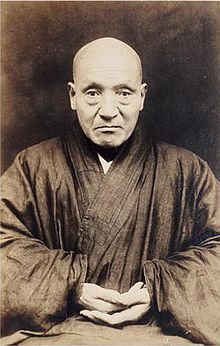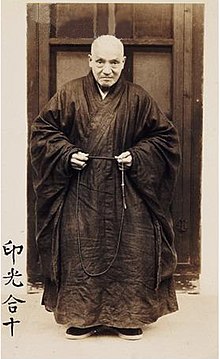The topic of this article may not meet Wikipedia's notability guideline for biographies. (May 2023) |
Shi Yinguang (Chinese: 釋印光; pinyin: shì yìnguāng; 11 January 1862 – 2 December 1940), or Yinguang for short, was a Chinese Buddhist monk and considered the 13th Patriarch of the Pure Land tradition. Yinguang lived during the rapid societal changes of the Republic of China, and is credited as a leader in the modern Buddhist revival movement. Yinguang promoted traditional Pure Land practices, such as reciting the nianfo, in a way that resonated with modern society.[1]


Biography
editYinguang was born in 1861 as Zhao Shaoyi (Chinese: 赵绍伊) in Shanxi Province, the youngest of three children, to Zhao Bing Gang (Chinese: 赵秉纲). Yinguang suffered from conjunctivitis, and suffered from poor vision in his youth,[1][2] but after recovering he was put to studying the Confucian classics in order to prepare for Imperial civil service exams.
After the death of a schoolmate, Yinguang reportedly took a more active interest in Buddhism.[1]
In 1881, Yinguang first ordained as a novice monk on Mount Zhongnan, at Lotus Flower Cave Temple (simplified Chinese: 莲花洞寺; traditional Chinese: 蓮花洞寺; pinyin: Lian Hua Dong Si), but was dragged back home by his older brother on a pretense that their mother was ill.[2] Yinguang later ran away from home and returned to Lotus Flower Cave Temple for good. There his role was a temple librarian, which required sunning scriptures to dry them out and prevent mildew. This allowed him more time to read scriptures.
By 1893, having traveled to a number of local temples in search of Pure Land Buddhist teachings, he settled at Dharma Rain Temple (Chinese: 法雨寺) on Mount Putuo. From here, he undertook the collection of funds to print and redistribute Buddhist texts on Pure Land teachings to a wider audience. By the 1910s, he had attracted a following of educated Buddhist laypeople who assisted in his endeavor.[1] By 1918, they distributed books by Yinguang including the Grand Antiquity Inner Response Book (Chinese: 太上感應篇; pinyin: Tai Shang Gan Ying Pian), and the All Embracing Four Methods of Training (Chinese: 了凡四訓; pinyin: Le Fan Si Xun) among others.[2]
In the 1920s Yinguang traveled in Nanjing promoting prison reform, social welfare and disaster relief. Such efforts continued until 1937 during the breakout of the Second Sino-Japanese War, where Yinguang relocated to Lingyun Temple (Chinese: 凌雲山; pinyin: Ling Yun Shan) which would be his last residence. In December 1940, Yinguang fell ill, and died on December 2 while seated in a lotus position.[2]
Teachings
editAccording to Charles B Jones, Yinguang's teachings espoused a return to traditional Confucian ethics, focusing on rebirth in the Pure Land through recitation of the nianfo along with other complementary Buddhist practices, and practicing charity in this life. He discouraged a psychological interpretation of the Pure Land and focused on a more literal one located to the West.[1][3] Unlike other contemporary teachers, Yinguang maintained a more traditional Chinese-Buddhist stance, but with emphasis on modern social welfare and delineating orthodox Buddhist teachings from traditional Chinese folklore.[1]
Yinguang's writings included a number of defenses of the Pure Land Buddhist teachings against criticism from the Chan Buddhist sect, such as the Treatise Resolving Doubts about the Pure Land (Chinese: 浄土決疑論; pinyin: Jìngtǔ Juéyí lùn). The opening text of the Treatise begins with Yinguang's autobiography, concerning his own despair towards his poor fortune in life, and his fears that he would fail to attain buddhahood in this life, then pivots toward a careful rebuttal of criticisms by an unnamed Chan-Buddhist monk. The Treatise meticulously analyzes source material in Buddhist canon, which undercutting Chan-Buddhist arguments.[3]
References
edit- ^ a b c d e f Jones, Charles B. (2021). Pure Land: History, Tradition, and Practice (Buddhist Foundations). Shambhala. pp. 102–105. ISBN 978-1611808902.
- ^ a b c d "Biography of Great Pure Land Master Yin Guang (1861-1940)". Retrieved 2023-05-19.
- ^ a b Jones, Charles B (2020). Chinese Pure Land Buddhism (Pure Land Buddhist Studies). University of Hawaii Press. pp. 50–51, 95. ISBN 978-0824888411.